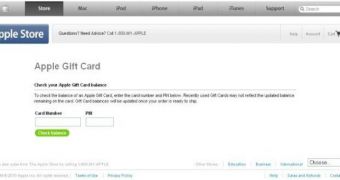Symantec, the renowned security firm headquartered in Mountain View, California, with offices around the world, has issued an advisory entitled “Phishing Apple Gift Cards.” Spoofing emails commonly include a link to a phishing website, and this one is no different, Symantec warns. The security expert also includes a few instructions to avoid falling into such traps.
“In the past month, phishing websites were observed to be spoofing the Apple brand” Symantec reveals on the company’s blog. “These fraudulent sites were created to steal legitimate Apple gift card numbers. Genuine Apple gift cards are an option for buyers to give family and friends gift cards for Apple computers or consumer electronics. These cards are accepted in any Apple Retail Store and can also be used for shopping on Apple’s websites,” Symantec explains.
The security firm goes to outline that, “The spam email messages that were sent claimed to provide an online facility for checking the balance amount for Apple gift cards, and included a link to the phishing website.” According to its findings, “The phishing site asked for the gift card number and its pin number in the hopes of tricking customers into believing that they could view their balances. Upon entering a card and pin number […] an error message is returned, stating that the balance enquiry is currently unavailable.” The phishers reportedly go as far as claiming that customers should contact customer care to find out the balance, and provide a valid phone number to add credibility.
Practices to avoid phishing attacks are offered by Symantec, which then enumerates what it calls “basic tips for avoiding online scams.” These are:
- Do not click on suspicious links in email messages. - Check the URL of the website and make sure that it belongs to the brand. - Type the domain name of your brand’s website directly into your browser’s address bar rather than following any link. - Frequently update your security software, such as Norton Internet Security 2010, which protects you from online phishing.
To be noted that such phishing scams affect everyone, regardless of the type of computer they use, or the operating system. Even those who rely on their mobile phones for email can fall into such a trap.

 14 DAY TRIAL //
14 DAY TRIAL //